When people climbed into their wagons to cross unknown territory in the interior, they had to be well prepared, as they didn’t know exactly when they would be able to get more of the basic ingredients to keep themselves fed.
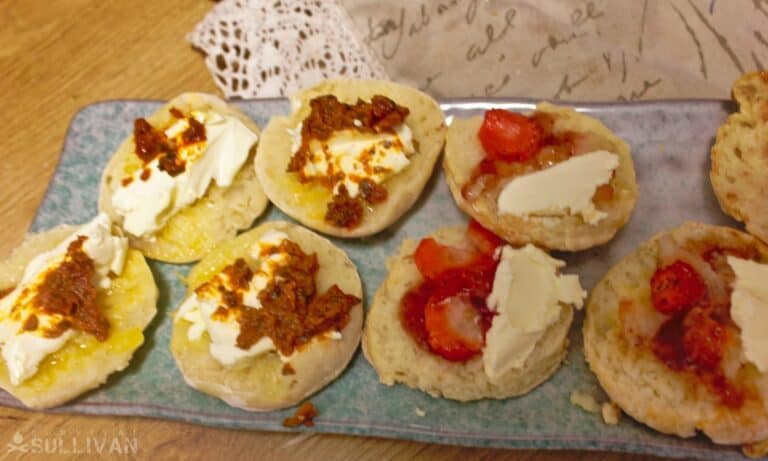
For a balanced diet, the pioneers needed some carbohydrates besides the protein from fresh fish or meat, as well as either fresh or dried fruit and vegetables.
To solve the carbs problem, folks tended to carry rice and flour in the wagons. From the flour they could make bread, but it wasn’t always possible to stop to bake bread as this takes an hour or so, besides the rise time, so this is where biscuits came in – quickly made they could be made in under half an hour and served with a meal to mop up the gravy, or served with savory or sweet toppings.
A word about biscuits if you are not American. Biscuits in the US are what the British and other commonwealth countries would call scones. What the Brits call biscuits, are called cookies in America and are sweet (for example choc-chip cookies).
A warning here, it is very easy to get bitter-tasting biscuits if the proportions of baking soda to the other dry ingredients are not right.
If the recipe says use 1 teaspoon of baking soda then stick to that, using a standard teaspoon (the weight of one teaspoon of baking soda is given as 4.8g).
If it says use butter then use butter and not coconut oil, Crisco, or margarine, as altering the ingredient ratios can result in failure.
Now, a word about baking soda and baking powder. Baking soda contains only sodium bicarbonate, whereas baking powder has three different ingredients: sodium bicarbonate, monocalcium phosphate, and either sodium aluminum sulfate or sodium acid pyrophosphate.
The sodium acid pyrophosphate acts as a double leavening agent – the first rise occurring when the baking powder is mixed with a liquid and the second rise is in the oven.
This is why you should make the mixture, then get the dough into the oven sooner rather than later, otherwise the baking powder loses its strength, as the reaction tends to peter out after a while.
Many people prefer to avoid baking powders with the sodium aluminum sulfate component these days, as there is a move towards reducing this in the diet.
The monocalcium phosphate is also a leavening agent, but is not the same as cream of tartar (potassium bitartrate), which was previously using in baking powder, as it is a bit slower acting.
A common question is, “Can I use baking powder instead of baking soda?” Yes, you can.
Many older recipes called for baking soda, but if you want to use baking powder you will realize that there is less sodium bicarbonate in the mix so you need to adjust. Most sources suggest using three teaspoons of baking powder to replace one teaspoon of baking soda.
So if using baking soda you would need 1/3 of a teaspoon to a cup of flour. If using baking powder you would use 1 teaspoon per cup of flour.
Now the pioneers didn’t have electric ovens to bake in, so the trail biscuits would have been made in a Dutch oven or large skillet,, but this took a while as you can only fit in a few at a time.
The Dutch oven would be placed over coals, with about 10 to 15 coals on top (depending on the size of the Dutch oven) fitting into that little lip on the lid, which is designed that way to keep the coals from rolling off, and distribute the heat evenly.
I am including two different pioneer trail biscuit recipes.
The first is the most basic, made with flour, baking soda and milk – I guess this was when the pioneers were down to the absolute minimum on supplies.
Then there is a recipe for when the cow taken along on the trail had sufficient milk, and they had camped out and had time to prepare buttermilk.
Many pioneer recipes used lard – rendered pig fat – for baking, but these days due to health concerns of using animal fats it is not used as much, even though 60% of it is unsaturated fatty acid.
If you are on a survival farm and have a cow you can substitute butter for the lard, but is should be unsalted butter. In the second alternative for pioneer trail biscuits butter and buttermilk are used.
The higher calorie count comes from the butter – buttermilk itself only has 99 calories per cup, whereas milk has 146 calories, so it’s not the buttermilk pushing up the count but the butter itself that has a whopping 1627 calories per cup.
I prepared both recipes, and baked them alongside each-other. You will see in the photos the differences in texture.
The ones with the buttermilk (or you can substitute full cream Greek yogurt) and the butter also cook to a more golden brown color and are light. The basic ones with flour, soda and milk were heavier and more densely textured.
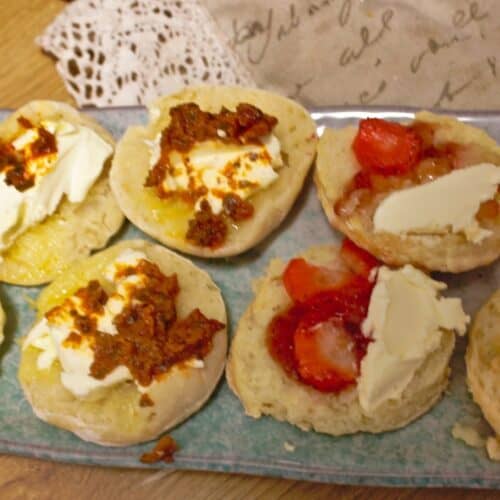
Pioneer Trail Biscuits with Baking Soda Recipe
Equipment
- Measuring cups and spoons
- Large mixing bowl
- Large baking sheet
- Parchment paper
Ingredients
- 1 ½ cups plain flour
- ½ tsp salt
- ½ tsp baking soda
- 1 cup milk at room temperature
Instructions
- Preheat your oven to 425 degrees F (220 C).
- In a large bowl place the flour and salt.
- Add a little milk at a time until a stiff dough is formed.
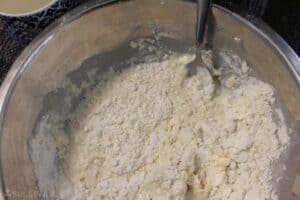
- Add the baking soda to the rest of the milk in the cup – there should be about a tablespoon left.
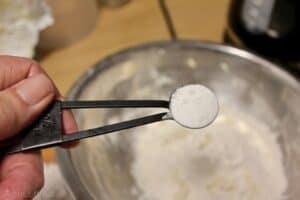
- Pour the milk and baking soda mix into the bowl and mix in well until dough forms.
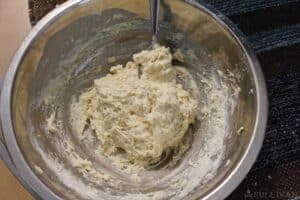
- Knead the dough gently about 4 to 5 times. Press out the dough gently so it about ½ inch thick.
- Cut into circles with a cookie cutter.
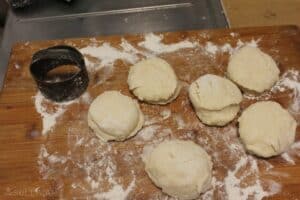
- Place around an inch from each-other on a baking sheet lined with parchment paper. (It makes clean up so much easier and the paper can go into the compost heap.) Alternately brush baking sheet with butter or coat with cooking spray.
- Bake for 15 minutes or until the edges start to turn golden.
- Remove from oven, and leave in tray to cool.
Notes
- These old fashioned soda biscuits are tasty with breakfast, lunch or supper. Made without using eggs, and butter, they are plain and easy survival item, but they are best eaten the same day.
- You can substitute powdered milk for the fresh milk if you only have dry goods stored. Just make up the powdered milk according to the specified ratios of powder to water, and mix so no lumps remain before adding to the flour.
Biscuits with Buttermilk Recipe Variation
Equipment
- Measuring cups and spoons
- Large mixing bowl
- Butter knives, x2 (optional)
- Large baking sheet
- Parchment paper
Ingredients
- 1 ½ cups plain flour
- ½ tsp salt
- ½ tsp baking powder
- 1 cup buttermilk at room temperature
- ¼ cup butter
Instructions
- Preheat your oven to 425 degrees F (220 C).
- In a bowl place the flour and salt and baking powder.
- Rub in the room temperature butter (not cold butter!) until the mix resembles coarse crumbs, using a light touch so the warmth of your fingers doesn’t make the butter melt too much. Alternatively, cut in the butter with two knives.
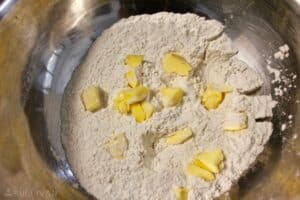
- Mix in buttermilk until dough mixture is uniformly moistened. Do not overmix!
- Add the buttermilk and stir to form a light puffy dough.
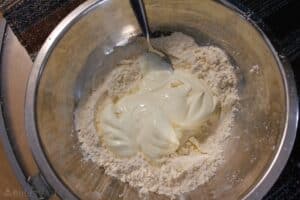
- Do not knead, but place the biscuit dough on a board and gently press out to about ½ an inch thick.
- Cut into circles with a cookie cutter.
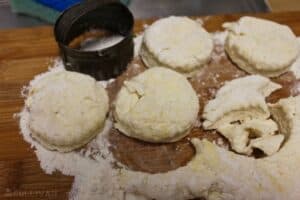
- Place around ½ inch from each other on a cookie sheet lined with parchment paper – it makes clean up so much easier and the paper can go into the compost heap. Buttermilk biscuits are on the left compared to the plain baking soda biscuits on the right, before they go into the oven.
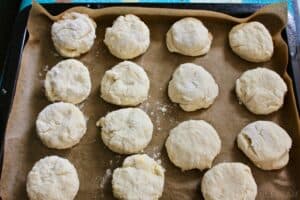
- Bake for around 15 minutes or risen, starting to gain color and are cooked through – take one out to test and if not done keep baking a little longer.
- Remove from oven and leave in tray to cool, or serve piping hot.
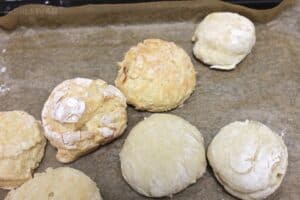
Notes
- Again, you can substitute buttermilk powder for the fresh buttermilk if you only have dry goods stored or don’t have enough buttermilk. Just rehydrate the powdered buttermilk according to the specified ratios of powder to water, and mix ingredients well.
Ideas for Sweet Toppings
- Honey
- Strawberry jam
- Apricot jam
- Blueberry jam
- Butter
- Whipped cream mixed with chopped up glacé (crystallized) fruit
Ideas for Savory Toppings
- Sprinkle with grated cheddar cheese
- Cream cheese
- Feta cheese chunks, preserved in a jar with herbs and olive oil
- Vegemite – a brown salty spread made from brewer’s yeast, beloved by Australians, the closest equivalent would be Marmite
- Peanut butter
- Hummus
- Pesto of all types
- Nut butter – almond, cashew, or macadamia
- Caramelized onion
- Roasted strips of red pepper
- Bacon pieces
- Fried chicken strips
- Any cold meat of choice
- Ham and mustard
- Powdered biltong and butter
- Pre-cooked Sausage ‘coins’
- Tinned tuna
- Tinned crab meat
- Smoked oysters
- Smoked mussels
- Tinned chicken
- Spam
- Corned beef
- Olives
- Pâté – either vegetable or meat based
- Chickweed fried in butter
- Fiddlehead fern sautéed in butter and garlic
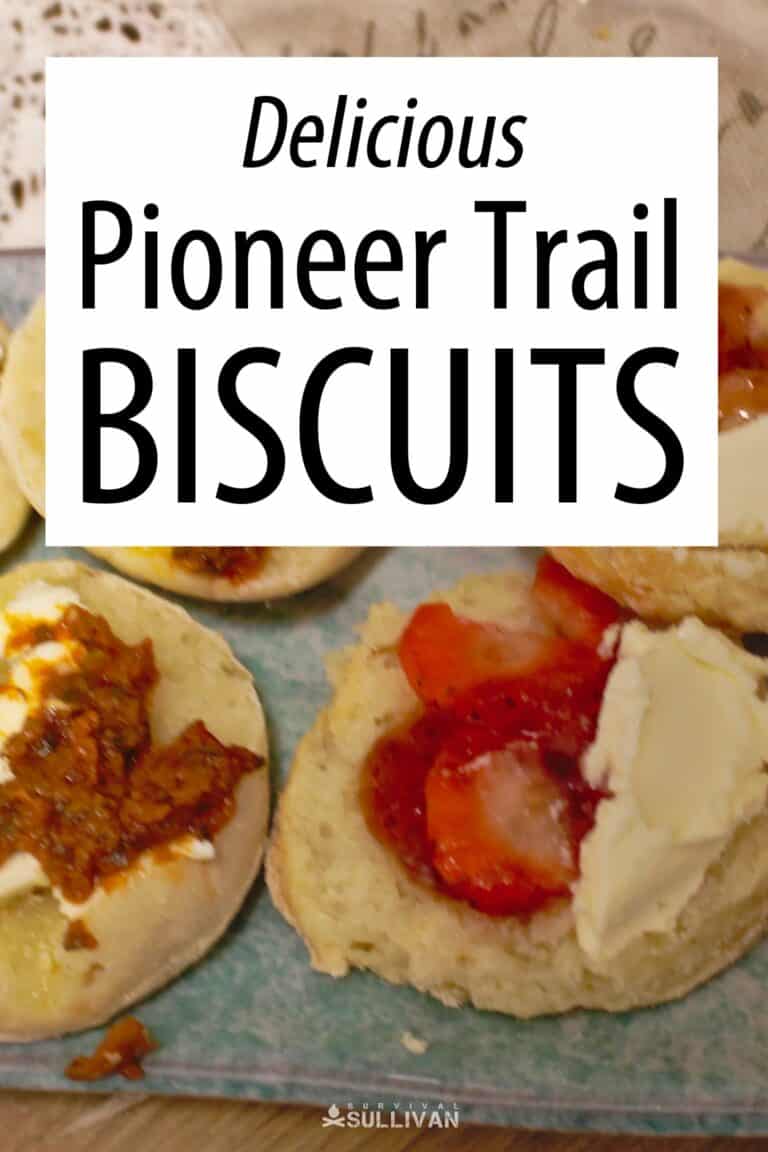

Traveler, photographer, writer. I’m eternally curious, in love with the natural world. How people can survive in harmony with nature has fueled my food safety and survival gardening practices.
At the age of 12, I found a newspaper advertisement for a 155-acre farm at a really good price and showed my parents one Sunday morning. They bought it and I happily started planting vegetables, peanuts, maize and keeping bees with the help of the local labor.
Once I married wherever we moved it was all about planting food, keeping chickens and ducks, permaculture and creating micro-climates. I learned how to build wooden cabins and outdoor furniture from pallets, and baked and cooked home-grown produce, developing recipes as I went along.

Do you know what their shelf life is?